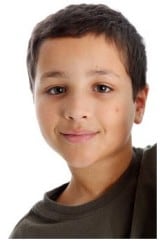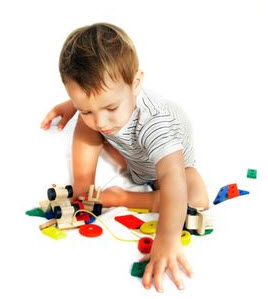How Do You Know if a 2 Year Old Is Autistic
Autism spectrum disorder (ASD) is a developmental inability acquired by differences in the encephalon. Some people with ASD take a known difference, such as a genetic condition. Other causes are not yet known. Scientists believe there are multiple causes of ASD that act together to change the most common ways people develop. We still take much to learn about these causes and how they impact people with ASD.
There is ofttimes nothing about how people with ASD look that sets them apart from other people. They may comport, communicate, interact, and larn in means that are different from near other people. The abilities of people with ASD can vary significantly. For example, some people with ASD may have advanced conversation skills whereas others may be nonverbal. Some people with ASD need a lot of help in their daily lives; others can piece of work and live with little to no support.
ASD begins before the age of three years and can terminal throughout a person's life, although symptoms may improve over time. Some children testify ASD symptoms within the start 12 months of life. In others, symptoms may non evidence upward until 24 months or later. Some children with ASD gain new skills and run across developmental milestones, until effectually 18 to 24 months of age and so they stop gaining new skills, or they lose the skills they one time had.
A diagnosis of ASD now includes several conditions that used to be diagnosed separately: autistic disorder, pervasive developmental disorder not otherwise specified (PDD-NOS), and Asperger syndrome. These weather are now all called autism spectrum disorder. Updated criteria for diagnosing ASD include problems with social communication and interaction, and restricted or repetitive behaviors or interests. It is important to note that some people without ASD might also have some of these symptoms. But for people with ASD, these characteristics tin make life very challenging.
Social Communication and Interaction Skills
Social advice and interaction skills can exist challenging for people with ASD.

Examples of social communication and social interaction characteristics related to ASD tin include:
- Avoids or does not keep center contact
- Does non reply to name by ix months of age
- Does non evidence facial expressions like happy, sad, aroused, and surprised past 9 months of age
- Does not play simple interactive games like pat-a-cake by 12 months of historic period
- Uses few or no gestures past 12 months of historic period (eastward.g., does not wave bye)
- Does non share interests with others (east.g., shows you an object that he or she likes past xv months of age)
- Does not indicate or look at what you bespeak to by xviii months of age
- Does not notice when others are hurt or sad by 24 months of age
- Does not pretend in play (e.1000., does not pretend to "feed" a doll by xxx months of age)
- Shows little involvement in peers
- Has trouble understanding other people's feelings or talking about ain feelings at 36 months of age or older
- Does not play games with plough taking by lx months of historic period
Restricted or Repetitive Behaviors or Interests
People with ASD have behaviors or interests that can seem unusual. These behaviors or interests fix ASD apart from conditions divers past only problems with social advice and interaction.
Examples of restricted or repetitive interests and behaviors related to ASD can include:

- Lines upwards toys or other objects and gets upset when gild is changed
- Repeats words or phrases over and over (i.e., echolalia)
- Plays with toys the same way every time
- Is focused on parts of objects (eastward.k., wheels)
- Gets upset by minor changes
- Has obsessive interests
- Must follow sure routines
- Flaps easily, rocks body, or spins self in circles
- Has unusual reactions to the way things sound, smell, taste, look, or feel
Other Characteristics
Near people with ASD accept other characteristics. These might include:
- Delayed language skills
- Delayed movement skills
- Delayed cognitive or learning skills
- Hyperactive, impulsive, and/or inattentive behavior
- Epilepsy or seizure disorder
- Unusual eating and sleeping habits
- Gastrointestinal issues (east.m., constipation)
- Unusual mood or emotional reactions
- Anxiety, stress, or excessive worry
- Lack of fear or more fear than expected
It is important to note that children with ASD may not have all or whatever of the behaviors listed as examples here.
Identification
The signs and symptoms of ASD can be identified by early on surveillance (collecting or gathering information) and screening (testing). Surveillance or developmental monitoring is an agile on-going process of watching a child grow and encouraging conversations between parents and providers nearly a child's skills and abilities. CDC's Acquire the Signs. Act Early. program has developed free materials, including CDC'southward Milestone Tracker app, to aid parents and providers work together to monitor children'due south development and know when there might be a business and if more screening is needed. Screening is when a parent or provider completes a checklist or questionnaire specifically designed to place problems that demand further evaluation. General developmental screening should occur at the ix-, 18-, and 24- or 30-calendar month well child visits and whenever a concern is expressed. Autism-specific screening should additionally occur at the eighteen- and 24- or 30-month visits and whenever a concern is expressed.
References
- https://pediatrics.aappublications.org/content/pediatrics/early on/2019/12/15/peds.2019-3447.total.pdf
Source: https://www.cdc.gov/ncbddd/autism/signs.html
0 Response to "How Do You Know if a 2 Year Old Is Autistic"
Post a Comment